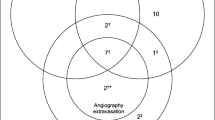Abstract
The evolution of multi-row detector computed tomography (MDCT) technology has resulted in evolving applications of CT angiography (CTA) in the trauma setting. In patients with significant blunt pelvic injuries, the immediate diagnosis and characterization of vascular injuries are of significant import given their morbidity and mortality in this patient population. The application of MDCT technology, specifically 64MDCT, to pelvic CTA is useful in evaluating for potential vascular injuries and may be integrated into admission trauma imaging in order to triage patients with blunt pelvic trauma to appropriate emergent intervention. This review will discuss the use of pelvic CTA in blunt pelvic trauma and its utility in detecting and characterizing vascular injury, including the differentiation of arterial from venous hemorrhage. Protocol considerations in pelvic CTA using 64MDCT technology will be detailed as well as the integration of pelvic CTA into torso CT trauma protocols.






Similar content being viewed by others
References
Biffl WL, Smith WR, Moore EE, et al. (2001) Evolution of a multidisciplinary clinical pathway for the management of unstable patients with pelvic fractures. Ann Surg 233(6):843–850
Brasel KJ, Pham K, Yang H, Christensen R, Weigelt JA (2007) Significance of contrast extravasation in patients with pelvic fracture. J Trauma 62(5):1149–1152
Brown JJ, Greene FL, McMillin RD (1984) Vascular injuries associated with pelvic fractures. Am Surg 50(3):150–154
Falchi M, Rollandi GA (2004) CT of pelvic fractures. Eur J Radiol 50(1):96–105
Hamilton JD, Kumaravel M, Censullo ML, et al. (2008) Multidetector CT evaluation of active extravasation in blunt abdominal and pelvic trauma patients. Radiographics 28(6):1603–1616
Jeffrey RB Jr, Cardoza JD, Olcott EW (1991) Detection of active intraabdominal arterial hemorrhage: value of dynamic contrast-enhanced CT. AJR Am J Roentgenol 156(4):725–729
Pereira SJ, O’Brien DP, Luchette FA, et al. (2000) Dynamic helical computed tomography scan accurately detects hemorrhage in patients with pelvic fracture. Surgery 128(4):678–685
Poole GV, Ward EF, Muakkassa FF, et al. (1991) Pelvic fracture from major blunt trauma. Outcome is determined by associated injuries. Ann Surg 213(6):532–538
Shanmuganathan K, Mirvis SE, Sover ER (1993) Value of contrast-enhanced CT in detecting active hemorrhage in patients with blunt abdominal or pelvic trauma. AJR Am J Roentgenol 161(1):65–69
Sheridan MK, Blackmore CC, Linnau KF, et al. (2002) Can CT predict the source of arterial hemorrhage in patients with pelvic fractures? Emerg Radiol 9(4):188–194
Shuman WP (1997) CT of blunt abdominal trauma in adults. Radiology 205(2):297–306
Willmann JK, Roos JE, Platz A, et al. (2002) Multidetector CT: detection of active hemorrhage in patients with blunt abdominal trauma. AJR Am J Roentgenol 179(2):437–444
Yao DC, Jeffrey RB Jr, Mirvis SE, et al. (2002) Using contrast-enhanced helical CT to visualize arterial extravasation after blunt abdominal trauma: incidence and organ distribution. AJR Am J Roentgenol 178(1):17–20
Yoon W, Kim JK, Jeong YY, et al. (2004) Pelvic arterial hemorrhage in patients with pelvic fractures: detection with contrast-enhanced CT. Radiographics 24(6):1591–1605
Stephen DJ, Kreder HJ, Day AC, et al. (1999) Early detection of arterial bleeding in acute pelvic trauma. J Trauma 47(4):638–642
Ben-Menachem Y, Coldwell DM, Young JW, Burgess AR (1991) Hemorrhage associated with pelvic fractures: causes, diagnosis, and emergent management. AJR Am J Roentgenol 157(5):1005–1014
Rossaint R, Cerny V, Coats TJ, et al. (2006) Key issues in advanced bleeding care in trauma. Shock 26(4):322–331
Cerva DS Jr, Mirvis SE, Shanmuganathan K, Kelly IM, Pais SO (1996) Detection of bleeding in patients with major pelvic fractures: value of contrast-enhanced CT. AJR Am J Roentgenol 166(1):131–135
Maturen KE, Adusumilli S, Blane CE, et al. (2007) Contrast-enhanced CT accurately detects hemorrhage in torso trauma: direct comparison with angiography. J Trauma 62(3):740–745
Romano L, Pinto A, De Lutio Di Castelguidone E, et al. (2000) Spiral computed tomography in the assessment of vascular lesions of the pelvis due to blunt trauma. Radiol Med 100(1–2):29–32
Schoepf UJ, Becker CR, Hofmann LK, et al. (2003) Multislice CT angiography. Eur Radiol 13(8):1946–1961
Vrtiska TJ, Fletcher JG, McCollough CH (2005) State-of-the-art imaging with 64-channel multidetector CT angiography. Perspect Vasc Surg Endovasc Ther 17(1):3–8
Anderson SW, Soto JA, Lucey BC, et al. (2008) Blunt trauma: feasibility and clinical utility of pelvic CT angiography performed with 64-detector row CT. Radiology 246(2):410–419
Author information
Authors and Affiliations
Corresponding author
Additional information
An erratum to this article is available at http://dx.doi.org/10.1007/s00261-010-9629-1.
Rights and permissions
About this article
Cite this article
Uyeda, J., Anderson, S.W., Kertesz, J. et al. Pelvic CT angiography: application to blunt trauma using 64MDCT. Abdom Imaging 35, 280–286 (2010). https://doi.org/10.1007/s00261-009-9525-8
Published:
Issue Date:
DOI: https://doi.org/10.1007/s00261-009-9525-8




